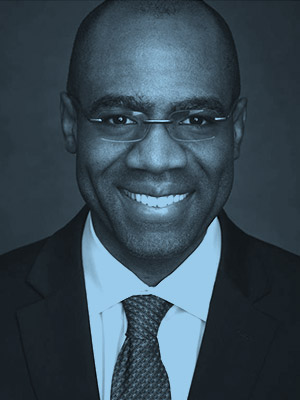
At the Nexus of the Next Thing: A Q&A With Dr. Julian Harris, Physician, Investor & Executive
has been intimately involved in practically every aspect of the American healthcare system. Currently a partner at Deerfield Management Co., a New York based health care investment firm, he previously led the healthcare team at the Office of Management and Budget, served as chief executive of the Massachusetts Medicaid program, worked as an advisor to Google Ventures and integrated and ran Cigna’s multi-payer providers services and home-based care businesses. His academic pedigree speaks volumes: a background in internal medicine and business that includes training at Harvard’s Brigham & Women’s Hospital and degrees from Duke, Oxford and Wharton.
Clearly, Harris is uniquely positioned to understand how the different components of healthcare work together – and how they could do better. And that’s precisely why we wanted to talk to him.
We recently visited with Harris about ways health services companies are responding to the shifts caused by COVID-19. Our conversation covered a range of topics – from investments to diversity and equity. His underlying theme: “partnerships,” and how individuals, groups and companies can or should work together to provide better care.
Here are excerpts from our mid-July interview, with quotes lightly edited for clarity.
Molly Cate: What’s changed and what’s stayed the same over the past 120 days?
Julian Harris: It’s almost cliché at this point, but there are a number of trends already underway that have been accelerated. The transition of care to the home and the adoption of telehealth are two examples in the healthcare services realm where I spend my time. But it’s broader than that, with our approach to thinking about vaccine research and the way people are approaching manufacturing, even the regulatory process.
One of the deeper questions is, “What is the new normal, and when will we know what that looks like across those domains?” That’s where it becomes more difficult, but it’s also where there’s a lot of opportunity.
MC: For example?
JH: If we take something like telehealth, even more important than the acceleration of patient adoption has been the acceleration of providers’ adoption of telehealth in the care of their own patients. There are a lot of primary care providers and specialists who saw telehealth as this thing that other people did – and maybe they had some mixed feelings or even suspicions about it. Now they’re saying, “Wait a minute. I really can use these tools to take care of my patients and do it in ways that gives me visibility into their lives.” Plus, it gives providers greater flexibility in terms of where and how they work and balance their time.
MC: We talk a lot about creating a sense of urgency as a lever for change. How should organizations – hospitals, health systems and PE funds – maximize this moment to improve care?
JH: For hospitals and health systems, it will still be important to have a certain volume of patients to survive because a lot of change has happened quickly, and it will take some time to percolate through the system in ways that allow them to right-size their footprint. For one thing, organizations will need to figure out their own new normal. They’ll need support, time and space to do that. And, not every provider has access to the needed data and technology or the necessary expertise to do that on their own. But, I do think that we’ll also see an acceleration of value-based care across settings and an acceleration in the shift of certain kinds of care outside of the hospital.
We’ve also seen an acceleration in new tech-enabled models of care in the home, and providers see the value of it for their patients. So, the question becomes, “How do we help their patients get access to home-based care, who are the right partners to work with?”
A lot of companies have partnerships in their DNA, and, a few sit at the nexus of this transition from hospital based care to the home. For examples from our portfolio, we invested in Contessa, which works through joint venture partnerships with health systems with support from health plans to provide hospital-level care in the home. Ready works with health plans, and health systems to provide urgent care in the home through a combination of telehealth and in person care delivered by EMTs. And Concerto Health takes risk from Medicare and Duals plans for providing comprehensive care for frail seniors in the home. These are just a few of the leading companies are at the nexus of the shift towards telehealth and home-based care.
MC: How has this experience affected your view of your investment work?
JH: This shift has validated a lot of the approaches that we’ve invested in and the approaches we’ve taken to identify priority areas. We’ve built a robust portfolio of companies that are part of the shift towards care in the home and that are engaged in telehealth, but in ways that provide a differentiated value proposition. So that’s been rewarding. On the data and analytics side, we’ve seen some of our other companies play a role in supporting COVID-19 research efforts.
Behavioral health and substance use disorder treatment are a couple of other areas where we’ve made investments, knowing they were important. There’s no question that both of those areas in this context are particularly needed.
MC: You mentioned working at the nexus of these shifts in care. How do companies do that going forward?
JH: There are a number of companies running after similar themes. Ultimately, some of it is about execution. Part of it is the ability to be nimble. Part of it is the ability to be responsive to the moment and the needs and priorities of partners like health plans or health systems, each of whom is experiencing this new world in their own way.
For us, it’s also seeing around corners. There are moments in healthcare investing when themes are popular, and everyone is talking about them. This is a moment when behavioral health, telehealth, home-based care… a lot of people would list the same three things in terms of what they’re focusing on. So, one of the arts and challenges of investing is to not just run after the same themes, but to look for the opportunity of the moment that others don’t see, or, to create a new opportunity.
It’s not one of our portfolio companies, but an example is Aspire, founded by Brad Smith. Brad literally saw a gap in the American healthcare system and decided to build a company, to create an industry, a new category of care delivery company, that didn’t exist before. An example in our portfolio is Somatus, where Dr. Ikenna Okezie has built the industry defining, disruptive kidney care and population health company that others have sought to emulate.
MC: What are other trends you’re keeping an eye on?
JH: This moment has put extraordinary strain on a lot of providers. I think it will reshape the way some providers think about their careers and whether they want to stay independent. This moment will be a major driver of consolidation in one form or another.
There will be greater recognition of the impact of social determinants, which have gained greater currency in the last four or five years. Access to transportation, housing and food can play a role in people’s health and health outcomes. We’re seeing that play out much more concretely.
There is certainly greater recognition of the impact of racial and ethnic disparities on health outcomes. COVID-19 has really brought this into focus given the differential morbidity and mortality related to the disease. I’m hoping that will translate into different approaches to innovation and thinking about ways to address the challenges in how people experience and navigate the healthcare system, how they’re supported and partner with their providers.
MC: Talk more about how we as an industry and as individual organizations can reduce the inequity in healthcare.
JH: It’s multidimensional. If we’re talking about the universe of investor-backed healthcare companies and investment firms, one place to start is to look internally and ask whether any given company looks like America. If not, why not? And, what are we doing about it? It’s a pretty basic question, but it’s helpful to orient opportunities for action. It’s so common with pitch decks or company websites to see little if any ethnic or gender diversity. We’re often so desensitized to it that you almost don’t notice it, until you notice it. At times, you’ll see 20 people on a company’s website, and not a single person of color, or ten people on the senior leadership team, and they’re all men.
In part, it’s because of the narrowness of peoples’ networks. People often build companies with people that they know, or, who are at least in their networks. But, the only way to change our networks and to change who works in a particular organization is for the company to not think of it as a box that needs to be checked. They have to decide that having a company that looks like America is a priority, and, that adds value and enables them to more effectively serve their customers and communities
There’s been quite a bit of research showing companies that are more diverse perform better. But, also, if you think about what we’re trying to do in healthcare, many investor-backed companies are trying to serve populations that are diverse. I feel strongly that if you’re trying to serve a diverse population, you’ll be more effective if there are people around the table when decisions are made who come from the communities you’re trying to serve to provide perspectives on what it might take to help move the needle. That’s at all levels of the organization – on the board, on the executive committee, and all the way through the ranks.
MC: What about providing better care?
JH: This is about looking at how you’re collecting the data to understand whether or not the area of care you’re focused on is delivering in a way that’s measurably different across a variety of lines, including race and ethnicity, gender, sexual orientation, and ability status.
From there, it’s tracking whether or not outcomes are the same or better or worse. Then, it’s about working to close those gaps in a data-driven way. But it has to start with data collection, and we have so many gaps in that infrastructure that it makes it challenging. Some innovative companies are beginning to think about their role in helping to address these gaps in information and action.
There are also opportunities to think about the intersection between the healthcare system – hospitals, doctors’ offices, etc., and the public health system. One of the other things COVID has brought into focus is that we have underinvested as a country in our local public health system and our local public health departments. That lack of investment has made it difficult for many patients. And while additional public dollars are desperately needed, there may also be opportunities for private companies to drive innovation and investment in public health technology and services similar to what’s happened in digital health. We’ve already seen that, with companies moving rapidly to develop and deploy symptom screening and contact tracing tools.
Julian Harris, M.D., is a Partner on the Healthcare Services team at Deerfield. Prior to his role at Deerfield, he was the founding President of CareAllies, Cigna’s family of multi-payer provider services and home-based care businesses, led US Strategic Operations for Cigna, served as an Adviser to Google Ventures (GV), led the health care team in the White House Office of Management and Budget (OMB), and served as the chief executive of the Massachusetts Medicaid program.
Dr. Harris holds a B.A. in Health Policy & Medical Ethics from Duke University, an M.Sc. from Oxford University, where he studied as a Rhodes Scholar, an MBA from Wharton School of Business and M.D. from the University of Pennsylvania’s School of Medicine. For his full bio, please click here.
Illustrations by Shannon Threadgill

